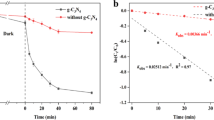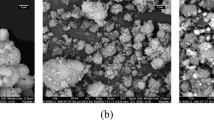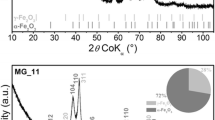Abstract
Microcystins, a group of hepatotoxin produced by cyanobacteria in eutrophic freshwater, have proven unreliable to be removed by conventional treatments. In this study, the photocatalytic degradation experiments of Microcystin-LR were conducted using nano-TiO2 thin film, prepared by solgel and dip-coating method, with low UVA intensity irradiation. Analysis results from SPE (solid-phase extraction) combined with HPLC method showed that Microcystin-LR whose initial concentration (μg/L) around that occurs naturally was easily to be removed by photocatalytic system. The degradation efficiency of toxin was influenced by the pH conditions, initial concentration and UV intensity. The maximum initial rate of photocatalytic degradation occurred at pH 4 and over 95% of 20 μg/L Microcystin-LR was decomposed within 120 min under 400 μW/cm2 UV illumination. The kinetic equations and parameters revealed that degradation reaction of trace level MC-LR, which was depicted by Langmuir-Hinshelwood kinetics model, was in accordance with pseudo first order kinetics process in appearance well. Under the condition of pH=6.7, irradiation intensity=400 μW/cm2 and initial concentration=20 μg/L, the corresponding pseudo-first-order rate constant k and half-life were determined to be 0.0157 min−1 and 44 min, respectively. During the range of 200–1000 μW/cm2, the degradation rate increases with incident intensity to the 0.82 power and the corresponding apparent quantum yield (Φ app) was found to be 5.19×10−8 g/J approximately.
Similar content being viewed by others
References
Vasconcelos V M, Pereira E. Cyanobacteria diversity and toxicity in a wastewater treatment plant. Wat Res, 2001, 35: 1354–1357
Carmichael W W. Cyanobacterial secondary metabolites—the cyanotoxins. J Appl Bacteriol, 1992, 72: 445–457
Dawson R M. The toxicology of microcystins. Toxicon, 1998, 36: 953–962
Falconer I R, Humpage A R. Microcystin-LR and liver tumor promotion: Effects on cytokinesis, ploidy, and apoptosis in cultured hepatocytes. Environ Toxicology, 1999, 14: 61–75
Chen Y, Yu S Z, Yang J B. Microcystins in drinking water and cancer mortality in a city along Taihu Lake. China Oncology (in Chinese), 2002, 12: 485–488
Zhou X F, Dong C H, Yu S Z. Study on hepatocarcinogenic factors in higher incidence regions of Taixing County. Modern Preventive Medicine (in Chinese), 1999, 26: 350–351
WHO (World Health Organization). 2nd ed. Addendum to Vol 2. Guidelines for drinking-water quality. Health criteria and other supporting information. 1998
Zhu G C, Lv X W. Removel of microctstins by conventional water treatment process. Environ Chem (in Chinese), 2002, 21: 584–589
Chow C W K, Drikas M, House J, et al. The impact of conventional water treatment processes on cells of the cyanobacterium Microcystis aeruginosa. Wat Res, 1999, 33: 3253–3262
Cornish B J P A, Lawton L A, Robertson P K J. Hydrogen peroxide enhanced photocatalytic oxidation of microcystin-LR using titanium dioxide. Appl Catalysis B: Environmental, 2000, 25: 59–67
Ollis D F, Pelizzetti E, Serpone N. Photocatalyzed destruction of water contaminants. Environ Sci Technol, 199, 25: 1523–1529
Lee S, Nashida K, Otaki M, et al. Photocatalytic inactivation of phage QB by immobilized titanium dioxide mediated photocatalyst. Water Sci Technol, 1997, 35: 101–106
Chen Z Y, Yu G, Zhang P Y. Photocatalytic degradation of organic pollutants under carbon black modified Titanium dioxide. Chin Sci Bull, 2001, 46: 1961–1965
Robertson P K J, Lawton L A, Cornish B J P A, et al. Processes influencing the destruction of Microcystin-LR by TiO2 photocatalysis. J Photochem Photobiol A: Chem, 1998, 116: 215–219
Shephard G S, Stockenstrom S, Villiers D D, et al. Photocatalytic degradation of cyanobacterial toxins in water. Toxicon, 1998, 36: 1895–1901
Lawton L A, Robertson P K J, Cornish B J P A, et al. Processes influencing surface interaction and photocatalytic destruction of microcystins on titanium dioxide photocatalysts. J Catalysis, 2003, 213: 109–113
Feitz A J, Waite T D. Kinetic modeling of TiO2-catalyzed photodegradation of trace levels of microcystin-LR. Environ Sci Technol, 2003, 37: 561–568
Shephard G S, Stockenstrom S, Villiers D D, et al. Degradation of microcystin toxins in a falling film photocatalytic reactor with immobilized titanium dioxide catalyst. Wat Res, 2002, 36: 140–146
Qing D, Rabani J. Photosensitization of nanocrystalline TiO2 films by anthocyanin dyes. J Photochem Photobiol A: Chem, 2002, 148: 17–24
Lawton L A, Edwards C, Codd A. Extraction and high performance liquid chromatographic method for the determination of microcystins in raw and treated waters. Analyst, 1994, 119: 1525–1530.
Tsuji K, Naito S, Kondo F, et al. Stability of Microcystins from cyanobacteria: effect of light on decomposition and isomerization. Environ Sci Technol, 1994, 28: 173–177
Chen W, Gan N Q, Song L R. Photodegradation dynamics of pure microcystin variants with illumination of fixed wavelength UV-light. Acta Chimica Sinica (in Chinese), 2004, 62: 142–147
Tunesi S. Influence of chemisorption on the photodecomposition of salicylic acid and related compounds using suspended TiO2 ceramic membranes. J Phys Chem, 1991, 95: 3399–3405
McMurray T A, Byrne J A, Dunlop P S M, et al. Intrinsic kinetics of photocatalytic oxidation of formic and oxalic acid on immobilised TiO2 films. Appl Catal A: General, 2004, 262: 105–110
Zhu X L, Feng X G, Yuan C W, et al. Photocatalytic degradation of pesticide pyridaben in suspension of TiO2: identification of intermediates and degradation pathways. J Mol Catal A: Chemical, 2004, 214: 293–300
Robertson P K J, Lawton L A, Munch B, et al. Destruction of cyanobacterial toxins by semicoductor photocatalysis. Chem Commun, 1997, 4: 393–394
Vasudevan D, Stone A T. Adsorption of catechols, 2-aminophenols, and 1,2-phenylenediamines at the metal (Hydr) oxide/water interface: Effect of ring substituents on the adsorption onto TiO2. Environ Sci Technol, 1996, 30: 1604–1613
Timothy N O, Robert T B. TiO2 photocatalysis for indoor air applications: Effects of humidity and trace contaminant levels on the oxidation rates of formaldehyde, toluene, and 1,3-butadiene. Environ Sci Technol, 1995, 29: 1223–1231
**e Y B, Yuan C W. Calculation method of quantum efficiency to TiO2 nanocrystal photocatalysis reaction. J Environ Sci, 2003, 14: 70–75
Author information
Authors and Affiliations
Corresponding author
About this article
Cite this article
Feng, X., Rong, F., Fu, D. et al. Photocatalytic degradation of trace-level of Microcystin-LR by nano-film of titanium dioxide. CHINESE SCI BULL 51, 1191–1198 (2006). https://doi.org/10.1007/s11434-006-1191-4
Received:
Accepted:
Issue Date:
DOI: https://doi.org/10.1007/s11434-006-1191-4




